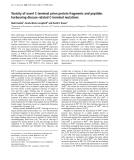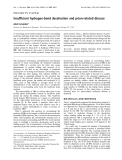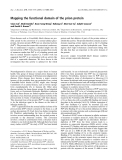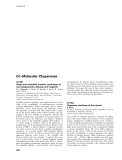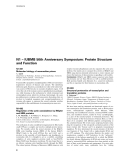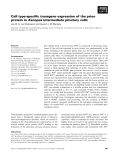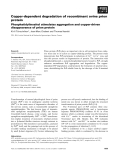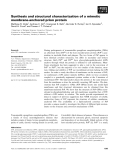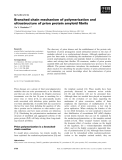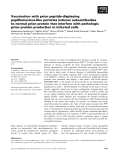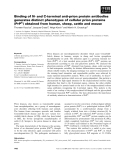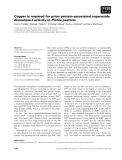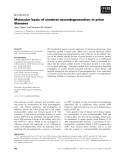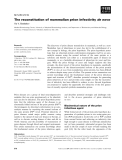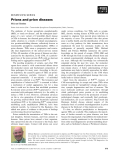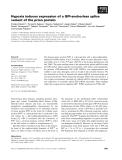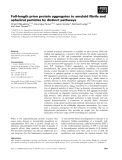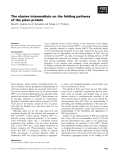
Prion protein
-
Mice expressing a C-terminal fragment of the prion protein instead of wild-type prion protein die from massive neuronal degeneration within weeks of birth. The C-terminal region of PrPc (PrP121–231) expressed in these mice has an intrinsic neurotoxicity to cultured neurones. Unlike PrPSc, which is not neurotoxic to neurones lacking PrPc expression, PrP121–231 was more neurotoxic to PrPc-deficient cells. Human mutations E200K and F198S were found to enhance toxicity of PrP121–231 to PrP-knockout neurones and E200K enhanced toxicity to wild-type neurones.
 10p
10p  system191
system191
 01-06-2013
01-06-2013
 33
33
 4
4
 Download
Download
-
A structuring and eventual exclusion of water surrounding backbone hydrogen bonds takes place during protein fold-ing as hydrophobic residues cluster around such bonds. Taken as an average over all hydrogen bonds, the extent of desolvation is nearly a constant of motion, as revealed by re-examination of the longest all-atom trajectory with explicit solvent [Y.Duan & P.A.Kollman (1998)Science 282, 740].Furthermore, this extent of desolvation is pre-served across native soluble proteins, except for cellular prion proteins....
 4p
4p  research12
research12
 23-04-2013
23-04-2013
 35
35
 2
2
 Download
Download
-
Prion diseases such as Creutzfeldt–Jakob disease are pos-sibly caused by the conversion of a normal cellular glyco-protein, the prion protein (PrP c ) into an abnormal isoform (PrP Sc ). The process that causes this conversion is unknown, but to understand it requires a detailed insight into the normal activity of PrP c . It has become accepted from results of numerous studies that PrP c is a Cu-binding protein and that its normal function requires Cu.
 9p
9p  tumor12
tumor12
 20-04-2013
20-04-2013
 56
56
 3
3
 Download
Download
-
Misfolded proteins, aggregates, and inclusion bodies are hall-marks of the cytopathology of neurodegenerative disorders including Huntington’s disease, Amyotropic lateral sclerosis, Parkinson’s disease, Prion diseases, and Alzheimer’s disease. The appearance of proteins with altered folded states is regula-ted by the protein folding quality control machinery and age-dependent. We have identified an unexpected molecular link between metabolic state, accumulation of damaged proteins, the heat-shock response and chaperones, and longevity....
 61p
61p  fptmusic
fptmusic
 11-04-2013
11-04-2013
 46
46
 5
5
 Download
Download
-
Transmissible spongiform encephalopathies (TSE) are fatal neuro-degenerative diseases of humans and animals. The underlying infectious agent, the prion, accumulates not only in the central ner-vous system (CNS) but also in secondary lymphoid organs. I will revisit the role of the immune system in peripheral prion pathogen-esis, while focusing on the mechanisms by which extraneural and extralymphatic prion infectivity develops.
 64p
64p  fptmusic
fptmusic
 11-04-2013
11-04-2013
 37
37
 4
4
 Download
Download
-
Protein aggregation is central to most neurodegenerative diseases, as shown by familial case studies and by animal models. A modified ‘amyloid cas-cade’ hypothesis for Alzheimer’s disease states that prefibrillar oligomers, also called amyloid-b-derived diffusible ligands or globular oligomers, are the responsible toxic agent. It has been proposed that these oligomeric spe-cies, as shown for amyloid-b, b2 -microglobulin or prion fragments, exert toxicity by forming pores in membranes, initiating a cascade of detrimental events for the cell. ...
 10p
10p  awards
awards
 06-04-2013
06-04-2013
 43
43
 3
3
 Download
Download
-
Prion diseases are characterized by the accumulation of a pathogenic mis-folded form of a prion protein (PrP) encoded by the Prnpgene in humans. In the present study in zebrafish, two transcripts and the corresponding genes encoding prion proteins, PrP1 and PrP2, related to human PrP have been characterized with a relatively divergent deduced amino acid sequence, but a well preserved overall organization of structural prion pro-tein motifs.
 14p
14p  awards
awards
 05-04-2013
05-04-2013
 41
41
 2
2
 Download
Download
-
The cellular form of prion protein (PrP C ) is anchored to the plasma mem-brane of the cell and expressed in most tissues, but predominantly in the brain, including in the pituitary gland. Thus far, the biosynthesis of PrP C has been studied only in cultured (transfected) tumour cell lines and not in primary cells.
 16p
16p  dell39
dell39
 27-03-2013
27-03-2013
 37
37
 3
3
 Download
Download
-
Prion protein (PrP) plays an important role in cell protection from oxida-tive stress due to its action as copper-chelating protein. The present study demonstrates that PrP participates in reductions of Cu 2+ to Cu + ions, and that this process results in fragmentation of protein.
 7p
7p  inspiron33
inspiron33
 26-03-2013
26-03-2013
 48
48
 5
5
 Download
Download
-
During pathogenesis of transmissible spongiform encephalopathies (TSEs) an abnormal form (PrP Sc ) of the host encoded prion protein (PrP C ) accu-mulates in insoluble fibrils and plaques. The two forms of PrP appear to have identical covalent structures, but differ in secondary and tertiary structure.
 15p
15p  inspiron33
inspiron33
 26-03-2013
26-03-2013
 38
38
 4
4
 Download
Download
-
The discovery of prion disease and the establishment of the protein only hypothesis of prion propagation raised substantial interest in the class of maladies referred to as conformational diseases. Although significant pro-gress has been made in elucidating the mechanisms of polymerization for several amyloidogenic proteins and peptides linked to conformational dis-
 10p
10p  galaxyss3
galaxyss3
 21-03-2013
21-03-2013
 53
53
 4
4
 Download
Download
-
Prion diseases are fatal neurodegenerative disorders caused by proteina-ceous infectious pathogens termed prions (PrP Sc ). To date, there is no pro-phylaxis or therapy available for these transmissible encephalopathies. Passive immunization with monclonal antibodies recognizing the normal host-encoded prion protein (PrP C ) has been reported to abolish PrP Sc infec-tivity and to delay onset of disease.
 12p
12p  galaxyss3
galaxyss3
 21-03-2013
21-03-2013
 38
38
 3
3
 Download
Download
-
Prion diseases are neurodegenerative disorders which cause Creutzfeldt– Jakob disease in humans, scrapie in sheep and bovine spongiform encephalopathy in cattle. The infectious agent is a protease resistant iso-form (PrP Sc ) of a host encoded prion protein (PrP C ). PrP Sc proteins are characterized according to size and glycoform pattern.
 11p
11p  galaxyss3
galaxyss3
 21-03-2013
21-03-2013
 49
49
 4
4
 Download
Download
-
The prion protein (PrP) is the key protein implicated in transmissible spongiform encephalopathies. It is a metalloprotein that binds manganese and copper. The latter is involved in the physiological function of the pro-tein. We have previously found that PrP expression inPichia pastorisaffects intracellular metal ion concentrations and that formation of protease-resistant PrP is induced by additional copper and⁄or manganese.
 8p
8p  galaxyss3
galaxyss3
 21-03-2013
21-03-2013
 30
30
 3
3
 Download
Download
-
The biochemical nature and the replication of infectious prions have been intensively studied in recent years. Much less is known about the cellular events underlying neuronal dysfunction and cell death. As the cellular func-tion of the normal cellular isoform of prion protein is not exactly known, the impact of gain of toxic function or loss of function, or a combination of both, in prion pathology is still controversial.
 6p
6p  galaxyss3
galaxyss3
 21-03-2013
21-03-2013
 63
63
 5
5
 Download
Download
-
The discovery of prion disease transmission in mammals, as well as a non-Mendelian type of inheritance in yeast, has led to the establishment of a new concept in biology, the prion hypothesis. The prion hypothesis postu-lates that an abnormal protein conformation propagates itself in an auto-catalytic manner using the normal isoform of the same protein as a substrate and thereby acts either as a transmissible agent of disease (in mammals),
 12p
12p  galaxyss3
galaxyss3
 21-03-2013
21-03-2013
 40
40
 4
4
 Download
Download
-
1The epidemic of bovine spongiform encephalopathy (BSE), or ‘mad cow disease’, and the subsequent emer-gence of a new variant of Creutzfeldt–Jakob disease (vCJD) in humans, has directed great political and sci-entific attention to a family of related neurodegenera-tive protein-misfolding diseases, collectively known as transmissible spongiform encephalopathies (TSEs) or prion diseases.
 1p
1p  galaxyss3
galaxyss3
 21-03-2013
21-03-2013
 54
54
 3
3
 Download
Download
-
Báo cáo khoa học: Hypoxia induces expression of a GPI-anchorless splice variant of the prion protein
The human prion protein (PrP) is a glycoprotein with a glycosylphosphat-idylinositol (GPI) anchor at its C-terminus. Here we report alternative splic-ing within exon 2 of the PrPgene (PRNP) in the human glioblastoma cell line T98G. The open reading frame of the alternatively spliced mRNA lacked the GPI anchor signal sequence and encoded a 230 amino acid polypeptide.
 12p
12p  galaxyss3
galaxyss3
 07-03-2013
07-03-2013
 39
39
 4
4
 Download
Download
-
As limited structural information is available on prion protein (PrP) mis-folding and aggregation, a causative link between the specific (supra)mole-cular structure of PrP and transmissible spongiform encephalopathies remains to be elucidated.
 11p
11p  media19
media19
 06-03-2013
06-03-2013
 50
50
 2
2
 Download
Download
-
A key molecular event in prion diseases is the conversion of the cellular conformation of the prion protein (PrP C ) to an altered disease-associated form, generally denoted as scrapie isoform (PrP Sc ). The molecular details of this conformational transition are not fully understood, but it has been suggested that an intermediate on the folding pathway of PrP C may be recruited to form PrP Sc .
 13p
13p  media19
media19
 06-03-2013
06-03-2013
 43
43
 3
3
 Download
Download
CHỦ ĐỀ BẠN MUỐN TÌM









